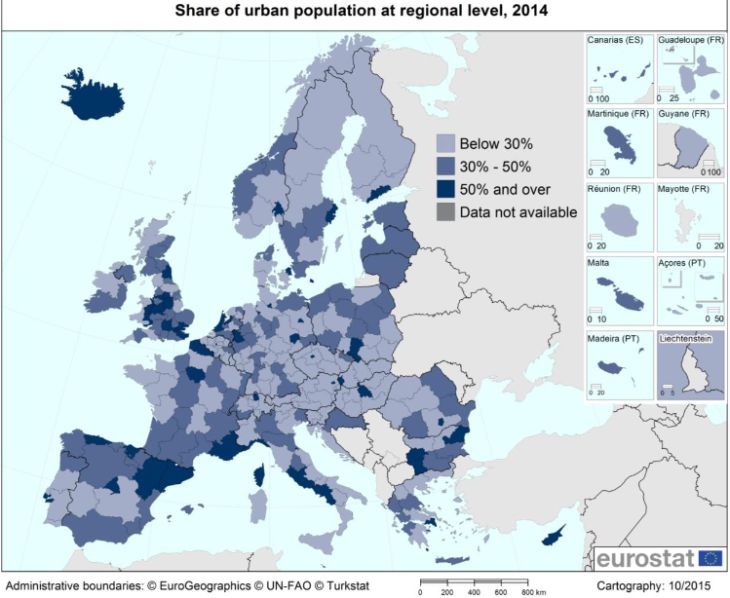Analytics, EU – Baltic States, Real Estate, Society
International Internet Magazine. Baltic States news & analytics
Saturday, 11.05.2024, 04:34
Proceeding urbanization in the EU member states
 Print version
Print version
On the occasion of the World Habitat Day, whose theme is “Public spaces for all”, Eurostat, the statistical office of the European Union, published some information on the population in the EU living in cities. See: http://ec.europa.eu/eurostat/documents/2995521/7020151/3-05102015-BP-EN.pdf/bf18a8b3-998c-476d-b3af-58292b89939b.

Most urban and most rural regions in the EU
The share of the EU population living in cities (2014) stood at 40.2% in 2014, compared with 27.8% for rural areas and 32.0% for towns and suburbs.
Across the EU member states, more than half of the population was living in cities in the United Kingdom (58.6%) and Cyprus (54.7%). A large part of the population was also concentrated in urban areas notably in Spain (48.5%), Malta (48.0%), Bulgaria (45.7%) and the Netherlands (45.2%).
In contrast, the largest share of the population was living in rural areas in Luxembourg (51.0%), followed by Slovenia (49.8%), Lithuania (47.6%), Slovakia (45.6%), Denmark (44.4%), Ireland (43.5%) and Romania (43.1%).
The population living in intermediate areas was predominant in Belgium (57.1%), while the population was almost evenly distributed between urban, intermediate and rural areas in the Czech Republic, Hungary and Finland.
Satisfaction with cities’ public spaces
On a scale from 0 (“not satisfied at all”) to 10 (“fully satisfied”), the EU residents aged 16 and over and living in cities rated their satisfaction with recreational and green spaces at 6.9.
Among the EU member states, satisfaction with recreational and green areas for the population living in densely-populated areas was highest in the three EU Nordic member states: Finland (8.5/10), Sweden (8.2/10) and Denmark (8.0/10).
At the opposite end of the scale, urban populations with the lowest rated satisfaction were those living in Greece (5.0/10), Bulgaria (5.3/10) and Cyprus (5.9/10).
The EU urban population aged 16 and over was generally satisfied with their city’s offer of recreational and green spaces, albeit to a lesser extent than the population living in thinly-populated areas.
The Baltic States’ satisfaction is at the level of 6-7.
More information:
· The UN website dedicated to the World Habitat Day for a better urban future;
· Eurostat publication “Quality of life – facts and views”;
· An interactive infographic on people’s well-being in the EU is available on the Eurostat website.








 «The Baltic Course» Is Sold and Stays in Business!
«The Baltic Course» Is Sold and Stays in Business!

